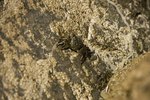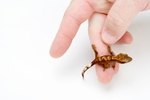
When a hermit crab molts, he sheds his exoskeleton -- the hard outer covering of his body that provides structure and support -- in order to gain size and regenerate lost or injured body parts. This process can be lengthy, taking up to three months to complete for large crabs and a couple of weeks for small crabs. Though it is not always obvious that a hermit crab is molting, some behavioral changes take place.
Step 1
Take note of the amount of time your hermit crab spends soaking in or drinking from his water dish. Hermit crabs need plentiful water to molt successfully and will increase water consumption before they molt.
Step 2
Look at your hermit crab's eyes and exoskeleton every day, seeking day-to-day changes. A hermit crab who is about to molt will tend to have cloudy, dull eyes and a chalky or ashen-looking exoskeleton.
Step 3
Observe your hermit crab's behavior. A hermit crab preparing to molt will sometimes become lethargic or inactive, often ignoring other hermit crabs in his enclosure and not eating.
Step 4
Notice any new or excessive digging behavior. Hermit crabs must dig under the substrate to molt successfully and will attempt to dig a suitable burrow for this purpose. You may notice your crab spilling water on the substrate as well. If your crab has completely buried himself under the substrate, molting is likely in progress.
References
Tips
- Provide enough substrate for your crab to completely bury himself during molting. A 10-gallon enclosure requires at least 6 inches of substrate for this purpose.
Warnings
- Never dig up a molting crab from substrate.
- If your crab attempts to molt on the surface, which normally occurs when the substrate isn't adequate for digging, and other crabs are in the enclosure, isolate the molding one to prevent the other crabs from harassing or eating him. Either move your hermit crab to a separate enclosure or place a halved 2-liter bottle over him with plenty of food and water inside.
Photo Credits
-
Jeffrey Hamilton/Lifesize/Getty Images




